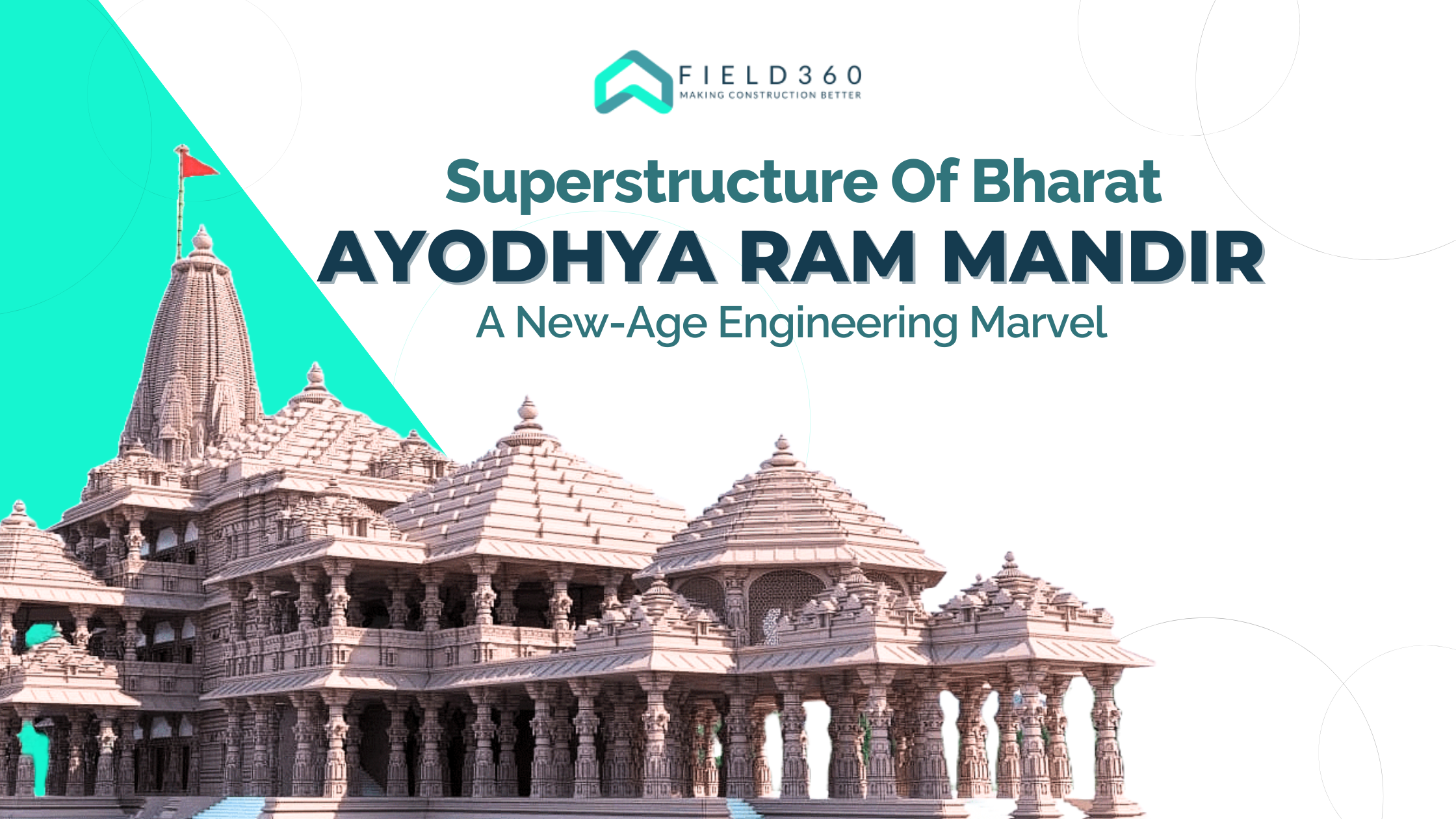Home / Blog / Construction Technology / Ram Mandir Construction Update: Facts, Structural Strength, and More
Have you ever thought that you would get to be a part of the ever-magnificent Shri Ram Mandir Construction that will become a golden history? Ayodhya’s Ram Mandir construction is a live example of one of its kind of architectural marvels.
January 22, 2024, the day of Pran Prathista (consecration) of Ram Mandir’s opening date Ayodhya, was celebrated as Diwali on the occasion of the homecoming of Lord Rama all over India and parts of the world.
But, do you know what makes the Ram Mandir structure so beyond grandeur? In this section, we will cover the secrets behind the structural strength of Shri Ram Mandir Construction. We will also discuss architectural style, craftsmanship, and other symbolic significance of Ayodhya temple construction.
Shri Ram Mandir Ayodhya Construction Overview
Shri Ram Mandir, the Hindu temple, which was inaugurated recently in the city of Ayodhya, Uttar Pradesh, is constructed at the site of Ram Janambhoomi. Ayodhya’s temple construction is being led by Shri Ram Janmabhoomi Teerth Kshetra Trust.
Ram Mandir construction was started on August 5, 2020, after a Bhoomi Poojan ceremony. The project of Ayodhya’s Ram Mandir construction company is led by Larsen & Toubro (L&T) and its Project Management Consultant (PMC) is Tata Consulting Engineers (TCE).
Shri Ram Mandir’s chief architect is Chandrakant Sompura, while Arun Yogiraj is the chief sculptor of Ram Lalla’s idol. The entire project is scheduled to be completed in December 2024, the official deadline.
Facts About Shri Ram Mandir Construction
|
Features
|
Description
|
|---|---|
|
Architectural Style
|
Māru-Gurjara branch of Nagara style
|
|
Distinctive Elements
|
Towering shikhara, intricate mandapas, three-story structure, five mandapas surrounding garbhagriha
|
|
Dimensions
|
235ft wide, 360ft long, 161ft high (planned to be the world's 3rd largest Hindu temple)
|
|
Material
|
Pink sandstone from Mirzapur and Bansi-Paharpur
|
|
Craftsmanship
|
Intricate carvings depicting mythological scenes and showcasing artistic heritage
|
|
Symbolic Significance
|
Follows Vastu shastra and Shilpa shastras, with elements holding symbolic meaning (e.g., 366 columns representing 360 deities and 6 seasons)
|
|
Modern Amenities
|
Green area, museum, research center, pilgrim facilities
|
Shri Ram Mandir Structure
Following a Māru-Gurjara architecture of Nagara style, the Ram mandir’s height in feet is 161 ft while being 360 ft long and 235 ft wide. It is a three-storey architectural structure with octagonal-shaped Garbha Griha (sanctum sanctorum), designed to allow sunlight to fall on the idol of Ram Lalla. Ram Mandir construction update has five mandapas between the Garbhagriha and the entrance: Kudu Mandapa, Nritya Mandapa, Rang Mandapa, Kirtan Mandapa, and Prarthana Mandapa. Each mandapa is decorated with a shikhara and 366 columns are made, each with 16 idols depicting various deities. Ayodhya Ram Mandir’s area in acres is 10 acres or 4.0 hectares with the main temple area spanning 2.67 acres. With complex facilities such as the prayer hall, lecture hall, educational facility, museum, and cafeteria, the Shri Ram Mandir structure weaves history and architectural brilliance.
Ayodhya Temple Construction Cost
The initial estimated Ram Mandir construction cost was around ₹1,800 crore. By January 2024, the current funding received is ₹3,500 crore where the major cost factors are contributed by high-quality materials like Rajasthani sandstone, Makrana marble, and other precious metals. The project is under oversight by Shri Ram Janmabhoomi Teerth Kshetra Trust and the phase 1 Ram Mandir construction date is completed by January 2024.
Ram Mandir Structural Strength
The foundation of the Ram Mandir construction is 15 meters deep, built entirely of stone using a special hardening technique. Primarily pink sandstone and white Makrana marble were used, known for their durability. The Ayodhya temple construction is said to be earthquake-resistant up to a magnitude of 6.5 and is expected to last for over 1000 years. The temple utilized a special Ram Mandir Construction technique of traditional Nagara style, known for stability and earthquake resistance. No iron or steel was used and 3D structural analysis for the next 2500 years was done. Central Building Research Institute is involved in ensuring the structural integrity and longevity of Shri Ram Mandir.
Ayodhya Ram Mandir Construction Company
|
Company
|
Role
|
Note
|
|---|---|---|
|
Larsen & Toubro (L&T)
|
Lead construction company
|
Donated their services, responsible for overall project management, design, and execution.
|
|
Tata Consulting Engineers Limited
|
Structural design consultants
|
Provided expertise in structural engineering and earthquake resistance.
|
|
Central Building Research Institute (CBRI)
|
Technical advisors
|
Offered technical guidance and conducted tests to ensure structural integrity.
|
|
National Geophysical Research Institute (NGRI)
|
Soil testing
|
Analyzed the soil characteristics at the construction site.
|
|
IIT Guwahati and IIT Madras
|
Seismic design consultants
|
Assisted in designing the temple to withstand earthquakes.
|
Conclusion
In this blog, we explored the intricate structure of Ram Mandir Construction and the planning by the excellent craftsmanship of the Ayodhya Temple construction company. You can create history too and track your projects from start to finish. Field360 is a tailor-made savior for all your construction management solutions, dedicated to maximizing your construction results.
Collaborate in real-time, record everything, and even track progress, Field360 manages on-site and off-site tasks so you don’t have to.
And while we’re on the topic of monumental projects, let’s talk about the Char Dham Rail Project. It’s not just a railway; it’s going to be Superstructure of Bharat, paving new routes and bringing current updates to your fingertips. Simplify your journey with the latest info on this grand venture.
Frequently Asked Questions
Who constructed Ayodhya Ram Mandir?
Larsen & Toubro designed and built the complex Ayodhya Ram Mandir in about three years in consultation with Tata Consulting Engineers Limited who provided expertise in structural engineering for Ram Mandir construction.
What is the total Ram Mandir construction cost?
Covering an expansive complex spanning 70 acres, featuring the main temple on 2.7 acres, measuring 161 ft in height, the Ram Temple has been among the most expensive religious projects in India in recent years, with an estimated cost of ₹1,800 crores (close to $217 million).
In which style Ayodhya Temple was constructed?
The Ram Mandir construction follows a Māru-Gurjara architecture of Nagara style which is said to be the secret behind its stability and earthquake resistance.
Is Ram Mandir Construction funded by the people of Ayodhya or by the Government?
Ayodhya Ram Mandir construction has seen inflows of investment from both central and state governments and thousands of donors across the country. The Shri Ram Janmabhoomi Teerth Kshetra trust has collected about ₹3,500 crore in donations.
What is the salary of Ram Mandir Priest?
As per the reports, the chief priest’s salary has been increased from Rs 25,000 to Rs 32,900 per month.












